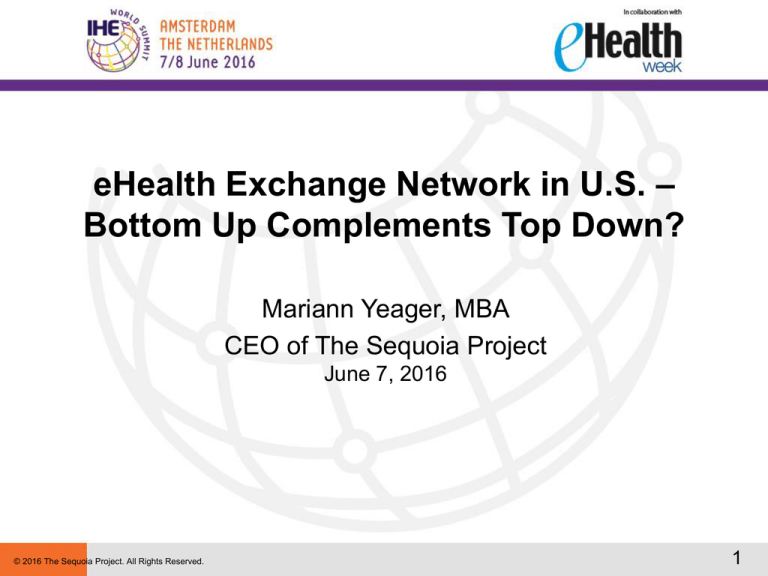
eHealth Exchange Network in U.S. –
Bottom Up Complements Top Down?
Mariann Yeager, MBA
CEO of The Sequoia Project
June 7, 2016
© 2016 The Sequoia Project. All Rights Reserved.
1
The Sequoia Project’s Role
The Sequoia Project is a trusted, independent
convener of industry and government.
We address the practical challenges of secure, interoperable
nationwide health information exchange.
SECURE
© 2016 The Sequoia Project. All Rights Reserved.
INTEROPERABLE
NATIONWIDE
2
The Sequoia Project Initiatives
The Sequoia Project’s
independent initiatives each
have their own:
•
•
•
•
Mission
Governance
Membership
Structure
The Sequoia Project is an ideal home for projects that
require a collaborative environment where multiple parties
with differing perspectives can work together.
© 2016 The Sequoia Project. All Rights Reserved.
3
Current Sequoia Project Initiatives
The eHealth Exchange is the largest and
fastest growing health data sharing network in
the US.
Carequality facilitates consensus on a
standardized, national-level interoperability
framework to link all data sharing networks from
across the entire US healthcare ecosystem.
RSNA Image Share Validation Program is an
interoperability testing program to enable
seamless sharing of medical images.
© 2016 The Sequoia Project. All Rights Reserved.
4
The Largest Health Information Exchange
Network in the U.S.
An initiative of
© 2016 The Sequoia Project. All Rights Reserved.
5
Choosing How to Connect
Centralized
Federated
“Hub” networks
The Internet
© 2016 The Sequoia Project. All Rights Reserved.
Federated with
Shared Services
(Hybrid)
6
Introduction to the
eHealth Exchange
Federal Govt
States
Regional
Networks
Care
Facilities
Tech
Vendors
Payers
Shared Governance and Trust Agreement
© 2016 The Sequoia Project. All Rights Reserved.
Pharmacies
Common Standards, Specifications & Policies
7
10 Years of Experience
•
•
•
•
A solid proven governance model
Common legal agreement minimizes
barriers to nationwide exchange
Mature capabilities, processes, operations,
testing, and strong cultural knowledge base
Testing and onboarding have simplified
efforts for partners to exchange nationwide
ONC Conceives the Nationwide
Health Information Network
(NHIN / NwHIN)
2006
•
•
•
•
Growth is in the number of medical groups
Federal partner programs leverage eHealth
Exchange as integral part of their interoperability
strategy
Relatively negligible maintenance costs
Recognized by SDOs as significant nationwide
community of implementers
First production exchange
between Social Security
Administration & MedVirginia
2009
2008
NHIN moves from
prototype to
production
© 2016 The Sequoia Project. All Rights
Reserved. pilot
Participation quadruples &
expands to all 50 states
2015
2012
NHIN transitions from government
to private sector & renamed
eHealth Exchange
2016
New initiatives increase
quality & types of
content shared
8
Largest Health Information Exchange
Network in the U.S.
Today, the eHealth Exchange connects:
26,000 medical groups
All 50 states
3,400+ dialysis centers
4 federal agencies
(DoD, VHA, HHS including
CMS, and SSA)
~50% of U.S.
hospitals
© 2016 The Sequoia Project. All Rights Reserved.
8,300 pharmacies
Supporting more than
100 million patients
9
eHealth Exchange Core Values
• Lead in national-level exchange of health information to
establish interoperability as a standard, while fostering and
supporting innovation
• Maintain openness and transparency in the conduct of
operations
• Cultivate trust and protection of information exchanged
• Encourage participation and inclusiveness across a diverse
set of stakeholders
• Provide for accountability, fairness and due process
• Maximize effectiveness and efficiency in the exchange of
health information
• Evaluate, learn and promote continuous improvement in its
own operations
© 2016 The Sequoia Project. All Rights Reserved.
10
eHealth Exchange has
a Trust Foundation
– Legal Agreement
– Governing Committee
– Operating Policies and
Procedures
© 2016 The Sequoia Project. All Rights Reserved.
eHealth Exchange uses
Technical Services
– Web services registry
(phone book of network
Participants)
– Security (x.509 Managed
Certificate Authority)
– Automated testing using
Aegis platform
11
National Use Cases and
Standards Supported
Specificatio
Use Cases
12
• Treatment / Care
Coordination
• Military / Veteran
Health
• Disability Benefits
Determination
• Quality Measures
Reporting
• Immunizations
• Consumer Access
• Life Insurance
© 2016 The Sequoia Project. All Rights Reserved.
ns &
Standards
• Query: SOAP /
SAML + IHE Suite
• Push: Direct,
Document
Submission /
Admin Distribution
• Content: C32,
CCDA, quality
measures
• FHIR
• Others under
consideration
12
eHealth Exchange Architectural Layers/Specifications
Profiles
Employing exchange patterns to enable clinical data enabled workflows
Care Summary Exchange
Quality / Admin Data Push
Claims Eligibility
Information Exchange
Employing lower-level layers to enable basic message exchange patterns
Patient
Discovery
Query for
Documents
Retrieve
Documents
Patient
Consent
Push
Publish /
Subscribe
Discovery, Message Security and Privacy
Message security, privacy, and interoperable healthcare data exchange
Web Services Discovery (UDDI)
Message Platform
Authorization Framework
Operational Infrastructure
Runtime systems supporting the eHealth Exchange
Security Infrastructure
(Managed PKI)
© 2016 The Sequoia Project. All Rights Reserved.
Web Services Discovery (UDDI)
13
IHE Mappings to eHealth Exchange Architecture
C32
IHE PCC
Profiles
Employing exchange patterns
to enable clinical data enabled workflows
Content
Care Summary Exchange
Quality / Admin Data Push
Claims Eligibility
IHE
IHE
IHE
IHE
IHE
XCPD
XCAto enable basic
XCAmessage exchange
BPPC patterns
XDR/XDM
Employing
lower-level layers
Information Exchange
Patient
Discovery
Query for
Documents
Retrieve
Documents
Patient
Consent
Discovery, Message Security and Privacy
Message security, privacy, and interoperable healthcare data exchange
Web Services Discovery
(UDDI)
Message Platform
Publish /
Subscribe
Push
IHE
XUA
Authorization Framework
IHE
Operational Infrastructure
Runtime systems supporting
the eHealth Exchange
ATNA
Security Infrastructure
(Managed PKI)
© 2016 The Sequoia Project. All Rights Reserved.
Web Services Discovery
(UDDI)
14
eHealth Exchange Query
Workflow
eHealth
Exchange
Patient Discovery
(IHE XCPD)
Query for Documents
(IHE XCA)
Retrieve Documents
(IHE XCA)
Participant
Gateway
(Acting as an
Initiator)
Found
patient
Lists zero or
more found
documents
eHealth
Exchange
Returns zero or
more
documents
Participant
Gateway
(Acting as a
Responder)
© 2016 The Sequoia Project. All Rights Reserved.
Searches for
patients
Searches for
Document(s)
Transmits
Document(s)
15
Onboarding & Testing Process
Staff Reviews
© 2016 The Sequoia Project. All Rights Reserved.
16
eHealth Exchange Validation Programs
Participant Testing
Product Testing
• Verifies that a participant’s
implemented exchange
gateway complies with the
eHealth Exchange
specifications, and validates
for known interoperability and
security risks
• Required for new participants
and existing who wish to test
for new functions or retest for
major system changes
• Focus on compliance and
interoperability testing of the
products “out of the box”
• Reduces cost and burden for
participants to onboard by
approximately 50%
• Reduces risk of interoperability
issues being introduced into
production, including the cost
and burden of fixing
interoperability issues and
deploying patches
© 2016 The Sequoia Project. All Rights Reserved.
17
eHealth Exchange Validated Products
Vendor
Product
Validated
Vendor
Product
Validated
Health IT systems complete rigorous
set of tests to validate:
• Conformance to underlying
standards and specifications
• Systems are free from known
interoperability issues - transport,
security, transactions and content
(if not MU certified)
• Configured and operate securely
(negative security tests)
© 2016 The Sequoia Project. All Rights Reserved.
18
eHealth Exchange Impact
Benefit
How eHealth Exchange Achieves Benefit
Reducing
Costs
Using common standards, legal agreements and governance
enables participants to reduce legal fees and avoid building custom
interfaces with trading partners.
Improving
Clinical and
Business
Decisions
Access to a nationwide data sharing network provides secure
access to the comprehensive health data that healthcare providers,
pharmacies and payers require to improve clinical decision making,
patient safety, process improvement and fair payment.
Federal participation in the eHealth Exchange supports data sharing
Exchanging
among all participants and with agencies such as Centers for
Data with
Medicare & Medicaid Services, the Department of Defense, the
Government
Social Security Administration and the Department of Veterans
Agencies
Affairs.
Planning for
the Future
© 2016 The Sequoia Project. All Rights Reserved.
Because the eHealth Exchange is governed by a representative set
of participants, its multi-purpose interoperability platform has the
ability to evolve and incorporate new use cases, standards, etc.
19
Who Benefits?
PATIENTS
• Improves Care Coordination and can reduce medical errors
• Expedites Social Security Benefits for the disabled
• Ensures that individuals with End Stage Renal Disease receive the
highest quality of care
PROVIDERS
• Allows access to critical information such as test results, medication
history and allergy information is available to providers when the
patient is transferred to another service.
• Enables exchange with government providers with national level ROI
• Can earn credit for MU2 Transitions of Care Measures
ACTIVE DUTY MILITARY, RETIREES, AND VETERANS
• Supports active duty military, retirees, their families, and veterans
throughout their care by making it possible for medical records to follow
the patient
© 2016 The Sequoia Project. All Rights Reserved.
20
Lessons Learned in Building a Federated
Health Data Sharing Network
An initiative of
© 2016 The Sequoia Project. All Rights Reserved.
21
Growing a Nationwide Network
Top Down
Bottom Up
• Government supports uniform
approach
• Strong government support
and participation in pilot
• Driving private sector adoption:
– Federal agencies
participation
– Meaningful use
– Alt. payment structures
• Provider and patient demand
• Private sector collaboration on
implementation details
• Health IT technologies
maturing
• Workflow improvements being
made
• Exploring additional uses of
the connectivity beyond federal
use cases
© 2016 The Sequoia Project. All Rights Reserved.
22
Common Legal Agreement
• Eliminates one-to-one legal agreements
• Saves money with uniform contracts,
policies and governance
• Contractual enforcement of compliance
• Provides transparency
• Creates clear expectations for participants
© 2016 The Sequoia Project. All Rights Reserved.
23
Test – Test - Test
• Testing should meet business and technical needs (e.g.
test once, exchange with many)
• Need for more rigorous testing of clinical documents
• Network-level testing should focus on increasing
assurances of interoperability in production
• Goal should be to reduce network-level testing over time
as interoperability “is built into” products
• Testing should evolve as health IT capabilities mature
• Incremental improvements over time essential
• Feedback loop to standards development organizations
© 2016 The Sequoia Project. All Rights Reserved.
24
Journey Towards “Seamless Interoperability”
•
•
•
•
•
•
•
Highly constrained specifications
Send strictly, receive liberally (can be expensive)
Key is to focus on the basics (simple is difficult enough!)
Collaborate early to ensure the strategy is not siloed
Very precise specifications are elusive
If a spec is testable then you’ve won the battle (or at least a skirmish)
Transport, security, web services are not the complete picture
– Data sharing policies, patient matching, consent, content, work flow
“Flexibility and optionality are the enemy of interoperability”
--Wes Rishel – Vice President & Distinguished Analyst – Gartner
© 2016 The Sequoia Project. All Rights Reserved.
25
Costs and Savings
• eHealth Exchange has a non-profit, co-op business model
• Seeking to provide services as close to free as possible shared savings model
• Leveraging a mutual investment in process, collaboration,
specifications, tooling
• Network testing is not a profit center
• “Test once, exchange anywhere” goal
• Upfront costs result in lower downstream costs by shifting
expenses forward in timeline where they are less expensive
• Optional vendor/product testing reduced level of effort
• Automation is the absolute key (quality, fast turnaround loop,
continuous testing, cost-efficient)
© 2016 The Sequoia Project. All Rights Reserved.
26
Our focus in 2016
Service Level
Guidance
Production testing
© 2016 The Sequoia Project. All Rights Reserved.
Increasing connectivity
Provider directory
Improve content testing
Patient
matching
27
Convene
© 2016 The Sequoia Project. All Rights Reserved.
Collaborate
Interoperate
28
Questions & Discussion
www.sequoiaproject.org
© 2016 The Sequoia Project. All Rights Reserved.
29
Thank You!
© 2016 The Sequoia Project. All Rights Reserved.
30


